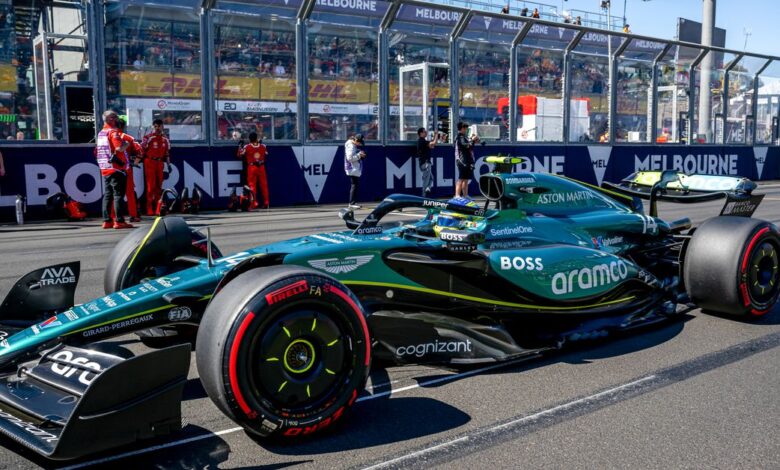Aston Martin F1 bringing key upgrades to Japanese Grand Prix

An emerging storyline ahead of this weekend’s Formula 1 Japanese Grand Prix?
Upgrades.
A number of teams have indicated they are bringing some upgrades to Suzuka. Both Sauber and Alpine have stated some new components are coming to the track, and of course there are the long-anticipated upgrades to the RB20 that Red Bull will be unveiling as well.
Another team bringing some upgrades to Suzuka?
Aston Martin.
In the team’s preview of the Japanese Grand Prix, Aston Martin Deputy Technical Director Eric Blandin offered a glimpse into the AMR24’s performance to date, the team’s development program, and what it takes to put in a good performance at Suzuka.
“AMR24 is performing as expected and we are where we thought we would be in the competitive order. We identified a number of areas for improvement over the winter and AMR24 has proved to be a step forward in all these areas,” said Blandin about the team’s 2024 challenger. “AMR24 is a strong platform for development, and we have a continuous development plan in place that will see us bring upgrades throughout the season.”
The reference to the AMR24 being a “strong platform for development” fits with the biggest question facing the team ahead of hte season, and ahead of the Japanese Grand Prix. Last year Aston Martin started strong, with the AMR23 performing like the second-best car on the grid in the early stages.
While that propelled Aston Martin to the top of the standings as the year began, as other teams started bringing upgrades, they began to slide. In their own words, Aston Martin struggled with mid-season development of the AMR23, and that opened the door for rivals such as McLaren to overtake them in the standings.
This year they are plotting a different course.
As far as the upgrades for the Japanese Grand Prix, Blandin makes it clear that while Aston Martin is bringing some changes, they are not alone.
“We are introducing an update at Suzuka as part of our continuous development, including changes to the floor, some bodywork and a new beam wing. I’m looking forward to seeing the hard work from so many talented people in the team take to the track for the first time. It’s always exciting to see how the race car performs and how we are doing on track,” described Blandin. “It’s all relative, however, as other teams will bring upgrades. We’re in a competitive development race, but hopefully our upgrades will be a step forward and help us to close the gap to the front.”
Blandin then discussed what it takes to succeed in Japan.
“Suzuka is a fantastic mix of low- and high-speed corners. This combination makes it really challenging and provides the opportunity to better understand the strengths and weaknesses of your car,” outlined Blandin. “If your car performs well here, then it should go pretty well at most circuits. It’s a special place to push a car to its limits: not only is it a real challenge for the drivers and engineers, but there’s a lot of history here and the support from fans is like nothing else.”
As far as handling a lap around Suzuka, and what teams might be competitive, Blandin made it clear that you should keep an eye on the first sector.
“The Esses in the first sector are very challenging, and we have seen in the past that if you have a car that is strong in sector one, you’re likely to be competitive at Suzuka,” said Blandin. “There are two low-speed corners – the hairpin and the final chicane – but the rest of the circuit is relatively medium- to high-speed so that is the crucial thing to consider when it comes to setup.”
This map of Suzuka from F1.com highlights the “Esses” in the first sector, as well as the hairpin (Turn 11) and the final chicane (Turns 16 through 18) Blandin references:
:no_upscale()/cdn.vox-cdn.com/uploads/chorus_asset/file/25370091/Screenshot_2024_04_03_at_7.22.41_PM.png)
Similar to Australia, Japan poses a challenge for the team and in particular those working back at the Silverstone factory. While some team members stayed in the area following the Australian Grand Prix, others returned to the region early from the United Kingdom to start adjust to the time change.
For those staying at the factory in Silverstone, they also have to adjust to the time difference.
“A lot of parts went straight to Japan from Melbourne following the Australian Grand Prix – because you don’t want to bring everything back to the UK and then send it off again. Most of the team who went to Australia came back home, but some stayed in that part of the world and have gone straight to Japan to minimise the change of time zone,” stated Blandin. “Those who travelled to Japan from the UK left a bit earlier than for a European race to also have time to adapt.
“We also have a lot of people who are working at the AMR Technology Campus but on the Japan time zone, so that means that they have to offset their days as well. They will start work in the early hours of the morning, before the first sessions get underway in Japan, and then work all the way through until after the sessions are complete. Many of them began shifting their body clocks from Monday in preparation for the weekend.”
But the focus will be on their upgrades, as how Aston Martin fares this weekend might give us our first look at whether they will truly get the mid-season development right.
Something that eluded them a year ago.



